Effective Lighting Choices for a Tranquil Bedroom
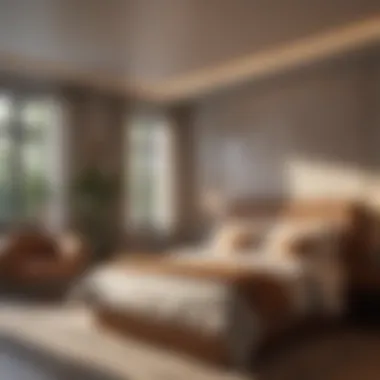
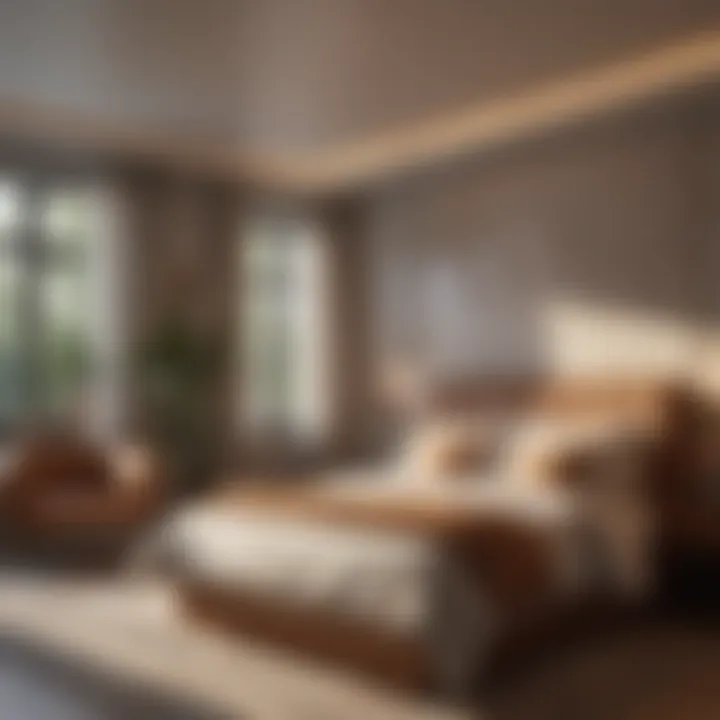
Intro
Creating the perfect ambiance in your bedroom goes beyond simply choosing a pretty light fixture. It's about striking the right balance between aesthetics and functionality. The right lighting can make a small room feel spacious or transform a bland space into a cozy retreat. As we dig into this topic, we'll explore how selecting the appropriate light bulbs, understanding their characteristics, and embracing contemporary trends can elevate your sanctuary.
Current Trends
Color Palettes
In recent years, there has been a notable shift towards warm, inviting color palettes in bedroom lighting. Soft whites, gentle yellows, and muted oranges dominate the scene, creating an atmosphere that promotes relaxation and comfort. These warm tones, unlike their cooler counterparts, are less harsh on the eyes, especially in the evenings when winding down is essential. People are increasingly opting for color-changing light bulbs too, which allow for personal customization of the ambiance, whether it be a cool blue for a calming effect or a warm amber for comfort.
Popular Styles
Lighting styles have evolved to mirror the tastes of modern decorators. Here are a few that have taken the spotlight:
- Minimalist: Characterized by clean lines and simplicity, minimalist fixtures can create a clutter-free look, perfect for those who lean towards an uncluttered aesthetics.
- Vintage/Industrial: The charm of exposed bulbs and metal fixtures signals a throwback to yesteryears, bringing about a nostalgia that many homeowners find appealing.
- Smart Lighting: As technology advances, smart lighting solutions have entered the picture. These allow homeowners to control their bedroom lighting through mobile apps or voice commands, offering both convenience and a touch of modernity.
Understanding these trends not only prepares you to make informed decisions but allows you to express your unique taste throughout your living space.
"Lighting is not just about illumination; it's about creating an environment that reflects your personality."
Visual Ideas
Gallery of Styled Bedrooms
Imagining your bedroom furnished with the latest lighting trends can be challenging without visual inspiration. A gallery filled with carefully curated bedroom designs showcases how various lighting styles and color temperatures can create distinct moods. You can easily find inspiration on platforms like Reddit or Pinterest, where users share their personal spaces, offering invaluable insights into what works harmoniously together.
Before-and-After Transformations
Consider documenting your own bedroom makeover with before-and-after photos. It's a powerful way to appreciate the impact of correctly chosen lighting. Many have found that merely switching out light bulbs can dramatically transform the entire atmosphere, breathing new life into a tired room.
Foreword to Bedroom Lighting
A well-lit bedroom is much more than a mere visual perk; it's a critical part of creating a peaceful retreat. Lighting in the bedroom can truly transform the atmosphere and contribute to your overall well-being. If rightly done, the right ambience can promote relaxation and sleep, while poorly considered lighting can stir unease. For many homeowners and renters, understanding how to harness light is essential for blending functionality with style.
When discussing bedroom lighting, several elements come into play. Think about how light interacts with your decor and mood. Those soothing dimmable lights can whisper "relax" after a long day, while bright bulbs are best for your morning routine, like searching for that elusive missing sock.
This section serves to guide you through the intricacies of bedroom lighting, emphasizing why it matters to select not just any light, but the right one. The light you choose has a role in the aesthetic, functionality, and energy efficiency of your space. Any illumination that doesn’t flatter your room could more or less leave you in the shadows.
If we delve deeper into the topic, you’ll realize that not all light serves the same purpose. Each fixture, hue, and bulb type paints a different narrative, and getting it right means ensuring your space feels welcoming and works for you.
"The light you let into your life is as crucial as the people you choose to share it with."
Ultimately, understanding the nuances of lighting will empower you to create a serene sanctuary tailored to your needs.
The Role of Light in Bedroom Ambiance
Light in the bedroom plays a starring role in setting the mood. Picture this: you walk into a space with warm, soft lighting that wraps itself around you like the blanket of a cozy evening, a stark contrast to bright, harsh lights that can feel jarring. Different lighting schemes can trigger various feelings—a warm hue can soothe, while a bright cool light can invigorate. Thus, the role of light extends into emotional realms.
Studies suggest that the right lighting can even influence your circadian rhythms, affecting sleep patterns. How's that for a bonus? For bedrooms, light should primarily work to invoke calmness and comfort. By layering different sources of light—ambient, task, and accent—you can create that all-important versatility. Perhaps you set the scene for a quiet read before bed, or you adjust the lights for a bright morning beginning. The power to shape the mood is right at your fingertips, literally!
Why Choosing the Right Bulb Matters
Why should the choice of bulb command your attention? Each bulb type contributes uniquely to the feel and function of your room, impacting energy efficiency and color quality. Think of it like choosing the right ingredient for your signature dish; a slight wrong move, and the end result can leave a lot to be desired.
Several aspects come into play:
- Color Temperature: A cooler light tends to promote alertness, while warmer light encourages relaxation.
- Energy Efficiency: Some bulbs use significantly less energy without sacrificing brightness. Focusing on those could save you a penny or two in the long run.
- Longevity: The lifespan of the bulb also factors. Investing in a longer-lasting bulb pays off as it reduces the hassle of frequent replacements.
Choosing the wrong bulb may lead to an unwelcoming atmosphere, one that feels too stark or oppressive instead of restful. In this case, a little forethought can go a long way. Being armed with knowledge helps you make choices that not only look good but also nurture comfort and utility in your sanctuary.
Types of Light Bulbs
Choosing the right type of light bulbs is critical when it comes to setting the mood and functionality of your bedroom. Different bulbs have different lumens, wattage, and color temperatures that serve varying purposes. Understanding these factors can significantly enhance how one experiences the space. Moreover, with the rise of energy efficiency concerns and smart technologies, opting for the ideal bulb has implications far beyond aesthetics.
Light bulbs can be categorized into several types, each with its unique traits and advantages:
- Incandescent Bulbs: Traditional in nature, these bulbs produce a warm glow, making them a cozy choice for bedrooms. However, they tend to consume more energy compared to their modern counterparts.
- LED Bulbs: The stars of energy efficiency, LED bulbs last significantly longer than other options and consume less power, making them an economically sound choice.
- CFL Bulbs: Compact fluorescent lamps (CFL) are also energy-efficient, yet they still provide a bit less customization in light temperature compared to LEDs.
- Halogen Bulbs: These are a type of incandescent but with some added benefits like better efficiency and longer life.
Understanding these varieties offers a pathway to making informed decisions about what suits your personal space best.
Incandescent Bulbs
Incandescent bulbs have been lighting homes since the late 19th century. They produce a soft, warm light that is gentle on the eyes and creates a relaxing atmosphere—ideal for winding down at night. Although they lack the energy efficiency of newer options, their warm hue can make one feel right at home.
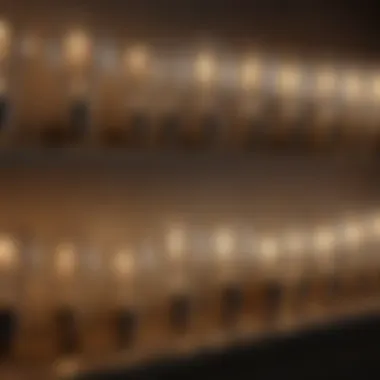

However, one must consider the energy consumption as they tend to draw more power, resulting in higher electricity bills over time.
LED Bulbs
LED bulbs have transformed the lighting landscape with their outstanding efficiency and longevity. They consume a fraction of the energy that incandescent bulbs do while producing vast amounts of light—perfect for illuminating difficult areas where clarity is needed. Furthermore, they are available in many color temperatures, allowing homeowners to customize their space to evoke specific moods.
Another alluring aspect of LED bulbs is their lifespan; they can last upwards of 25,000 hours. This makes them not just a cost-effective solution but also a sustainable option for concerned consumers.
CFL Bulbs
Compact fluorescent lamps (CFLs) offer a middle ground between incandescent and LED lighting. They use about 70% less energy compared to incandescent bulbs and have a longer lifespan, averaging around 10,000 hours. However, CFLs must be handled carefully due to the presence of small amounts of mercury. This fact might make the environmentally-conscious think twice about using them, especially in spaces where breakage could be an issue.
While they are generally less popular than LEDs, they create a pleasant light output that can suit various styles.
Halogen Bulbs
Halogen bulbs are essentially an improved version of incandescent bulbs. They are more energy-efficient and have a longer lifespan, often lasting around 2,000 hours. They emit a bright, white light that works well in spaces needing clear visibility. The downside is that they still produce considerable heat, necessitating care when selecting fixtures to avoid any fire hazards.
In summary, knowing the various types of light bulbs helps in making educated decisions for your bedroom. This understanding, paired with an awareness of how each type interacts with other lighting choices in your room, can lead to a more satisfying living space.
Understanding Light Quality
Light quality plays a crucial part in shaping not just the mood of your bedroom but also its functionality. In a space where you may relax, unwind, or even do activities like reading or working, the kind of light you choose has profound impacts on comfort and aesthetics. Getting light right can transform a room from merely adequate into a soothing sanctuary.
When we talk about light quality, we’re essentially discussing attributes like color temperature, brightness, and how they affect our day-to-day lives. The interplay between these factors influences not only how we perceive colors and details within the room but also alters our emotions. A well-lit bedroom, tailored to your specific needs, fosters a sense of calm and boosts productivity when needed.
Color Temperature: The Warm versus Cool Debate
Color temperature measures how warm or cool a light appears, typically expressed in Kelvin (K). It’s easy to get lost in the technical jargon, but the essence boils down to two clear categories—warm light and cool light.
- Warm Light (below 3000K): Think soft yellows and light golds. This type of light is often associated with cozy atmospheres. It’s perfect for winding down at the end of a long day. If you like to read in bed or enjoy a tranquil vibe while having a cup of tea, warm light may just be your best friend.
- Cool Light (above 3000K): Emitting a bluish hue, cool light is vibrant and invigorating. It’s great for activities that require focus, like working or organizing a closet. However, too much cool light can sometimes be overstimulating in a bedroom, possibly leading to restlessness during the night.
Finding a balance is key. Many homeowners opt for a mix of both to create an adaptable atmosphere, which allows the bedroom to morph into what they need it to be at any given time.
Brightness Levels and Their Impact
Brightness, measured in lumens, is another pillar of light quality. Brightness levels can either enhance or detract from your experience in the bedroom. Low brightness can create a dimly lit space that’s relaxing but might not be ideal for focused tasks, whereas overly bright environments can feel harsh and unwelcoming.
Here are some considerations:
- Ambient Light: This is often your primary source illuminate your bedroom. It should be bright enough to provide safety and comfort, particularly during nighttime.
- Task Lighting: For specific activities like reading or sewing, adjustable task lights can enhance visibility without flooding the entire room with light.
- Accent Lighting: Used to highlight decor or architectural features, accent lights can create focus points that draw the eye and elevate the bedroom’s design.
Ultimately, achieving the right brightness involves layering different light sources and adjusting them according to the time of day and your activities. Not only does this create a versatile environment, but it can also change the entire essence of the bedroom.
"The quality of light within a room influences not only its aesthetics but also your daily wellbeing."
By taking the time to understand the nuances of light quality, you equip yourself with the knowledge to make informed choices that resonate with your lifestyle, enhancing both comfort and functionality in your bedroom.
Energy Efficiency Considerations
When it comes to bedroom lighting, energy efficiency holds a central place in both ecological mindfulness and personal finances. The right choice of light bulbs can impact not just how cozy your bedroom feels, but also how much you’ll have to fork over on your monthly electricity bills. Hence, it demands attention. There's an undeniable responsibility in selecting lighting that minimizes energy use while maximizing illumination and atmosphere.
Quote: "Choosing efficient lighting is not just a decision for your home, it’s an investment in your lifestyle and the environment."
Comparing Energy Consumption Across Bulb Types
Each type of light bulb presents a different energy consumption profile. Understanding these distinctions can help you make informed choices. Here’s a practical breakdown:
- Incandescent Bulbs: They are the oldest technology and use the most power, typically consuming around 60 to 100 watts for standard options. You’ll get nice warm light, but the cost of running them often leads to sticker shock on your utility bill.
- CFL Bulbs: Compact fluorescent lamps can be quite efficient. They use about 13 to 15 watts to produce the same light output as an incandescent. Despite their better performance, many people find their light quality not to their liking.
- LED Bulbs: Light-emitting diodes are the champions of energy efficiency, consuming only about 8 to 12 watts. Their initial price might set you back a bit more, but they pay off in longevity and lower energy use.
- Halogen Bulbs: Halogen lamps are a more efficient version of incandescent bulbs, using about 30% less energy. They are brighter and last longer, but they still can't quite match LEDs for efficiency.
Being aware of these numbers can provide a clear picture for homeowners. The choice is often not just about the upfront cost, but the energy saved in the long run.
The Long-Term Cost Benefits of LED Lighting
The long-term advantages of LED lighting can be seen in three essential areas, namely longevity, energy costs, and environmental impact. Incorporating LEDs into your bedroom's lighting plan isn't just about saving a buck; it’s a step towards creating a more sustainable living environment.
- Longevity: LED bulbs can last between 15,000 to 50,000 hours, which means changing them is less frequent. That’s less hassle and fewer trips to the store, not to mention less waste in landfills.
- Energy Costs: The difference in energy usage can be prominent. For example, replacing a standard 60-watt incandescent with a 10-watt LED can save you approximately $100 over the light bulb's lifetime. Add it up over several bulbs in your home, and the savings start to resemble something substantial.
- Environmental Impact: Using less energy reduces the demand on power plants, thus lowering carbon emissions. Being eco-conscious while enjoying your well-lit sanctuary isn’t just desirable; it’s imperative.
Such factors make LEDs a clear frontrunner in the race for energy efficiency. The initial investment pays off significantly over time, as you enjoy lower electricity bills and a smaller carbon footprint.
Making educated choices about lighting can transform your bedroom into a haven while also being kind to both your wallet and the environment.
Smart Lighting Options
In recent years, smart lighting has gained traction in homes, allowing for a tailored approach to illumination that fits individual lifestyles and preferences. The integration of technology into bedroom lighting not only enhances convenience but also promotes energy efficiency and personalization. With smart bulbs, homeowners can adjust brightness and color, creating an ambiance that suits various activities, be it winding down with a book or energizing oneself to start the day.


The benefits of adopting smart lighting include:
- Energy Efficiency: Smart bulbs consume less energy than their traditional counterparts. By incorporating motion sensors or timers, homeowners minimize energy wastage.
- Customization: With the ability to change color temperatures and brightness via apps, one gains complete control over their space.
- Convenience: Voice-control features allow users to adjust settings without lifting a finger, an undeniable perk especially during late-night routines.
"Using smart technology for lighting is like having an assistant for your room, ready to change the mood whenever needed."
By embracing these intelligent options, the potential to craft an inviting and adaptable bedroom environment becomes greatly enhanced.
Prelude to Smart Light Bulbs
Smart light bulbs differ significantly from conventional bulbs. Instead of just providing a fixed brightness level, these bulbs can be adjusted in real-time to suit various moods and tasks. These bulbs connect to your home’s Wi-Fi network, allowing for control through a smartphone app or voice commands, often compatible with platforms like Google Home and Amazon Alexa.
Some notable features of smart light bulbs include:
- Adjustable Color Temperature: Transition from a warm glow in the morning to a cooler, energizing brightness in the afternoon.
- Programmable Settings: Set schedules for your lights to turn on or off, giving a sense of security when away from home.
- Remote Access: Control your lighting from anywhere, ensuring that your home always feels welcoming.
How to Integrate Smart Lighting into Your Bedroom
Incorporating smart lighting into your bedroom doesn’t have to be daunting. It begins with simple steps:
- Choose the Right Bulbs: Look for bulbs that fit within your existing fixtures. Brands like Philips Hue and LIFX offer a variety of styles.
- Set Up the Hub: Many smart bulbs require a hub to connect to your Wi-Fi. Familiarize yourself with the installation process, typically outlined in the product’s manual.
- Download the App: Most smart bulbs come with specific apps. These apps allow you to control lighting from anywhere, whether you’re lounging on the couch or getting ready for bed.
- Experiment with Colors and Brightness: Play around with different shades and brightness levels. Don’t hesitate to try various settings until you find the perfect combination.
- Integrate with Other Smart Devices: If you have other smart home gadgets, think about integrating them. For instance, linking your smart speaker can allow voice-controlled lighting adjustments.
Ultimately, integrating smart lighting is about enhancing both comfort and functionality. As you embrace this technology, the dynamic nature of your bedroom's lighting can transform the space into a true sanctuary.
Choosing the Right Fixtures for Bulbs
When it comes to bedroom lighting, finding the right fixtures is just as crucial as selecting the ideal bulbs. Fixtures are the unsung heroes that can make or break the atmosphere of your bedroom. Instead of simply providing shelter for the bulb, they play a significant role in the overall aesthetic and functionality of your space. Thoughtful fixture selection can lead to a harmonious blend of light and style, ensuring both beauty and utility.
One key benefit of choosing the right fixtures is their ability to enhance the quality of light produced by your bulbs. Fixtures can modify how light is distributed, whether it’s focused, diffused, or even reflected. This tailored approach to light allows you to set distinctive moods, depending on the task at hand - reading, relaxing, or romanticizing the evening.
Moreover, fixtures can serve as a focal point or accent in a room. A well-chosen light fixture can complement existing decor and enhance the visual narrative you've created in your bedroom. It can be a statement piece that draws attention or a subtle addition that melds seamlessly into the background. Striking that balance is where the magic happens.
Types of Fixtures to Consider
Here are some types of lighting fixtures to ponder over:
- Chandeliers: These hang from the ceiling and can be a centerpiece of elegance. Perfect for grand styles or when you want something eye-catching.
- Pendant Lights: Often suspended in a unique manner, pendant lights can add dimension to your room. They work particularly well over bedside tables or reading nooks.
- Wall Sconces: These fixtures are affixed to the wall and are great for saving space. They can provide ambient or task lighting and enhance the room’s style.
- Lamps: Table and floor lamps provide flexible lighting options. They come in a variety of shapes and styles, allowing you to express your personal taste.
- Recessed Lighting: This type involves fixtures installed into the ceiling, giving a clean, modern look. They can create overall illumination without taking up space.
Considering these options opens up avenues to customize your bedroom ambiance effectively. Just remember, the heart of the matter is balancing functionality with design ethos.
Matching Fixtures with Bulb Types
The fixture and bulb synergy is where the practical and aesthetic aspects truly converge. Here’s what you ought to keep in mind when selecting bulbs corresponding to your chosen fixtures:
- Match Watts with Fixtures: Ensure that the bulbs' wattage is suitable for the fixture. Utilizing a bulb that exceeds the recommended wattage can pose safety hazards.
- Consider Atmospheric Effects: If you have a dimmer switch, opt for dimmable LED bulbs to achieve versatile light levels. This makes for smoother transitions between an energizing and a soothing atmosphere.
- Shape Matters: Certain fixtures, such as chandeliers, may require specific bulb shapes like globes or candles. Picking a bulb that harmonizes with the fixture shape can enhance the visual appeal.
- Color Compatibility: The warmth or coolness of a bulb’s color temperature can impact how a fixture is perceived. A warm bulb in a modern fixture can evoke a contrasting vibe - warmth may soften hard lines, adding coziness.
A thoughtful blend of fixtures and bulbs elevates the bedroom experience, creating spaces that are not only functional but also deeply inviting.
By considering these elements, you can ensure that every lighting installation in your bedroom is not just a source of illumination, but also a reflection of your style and intentions.
Layering Light for Versatile Spaces
In the quest to create a cozy bedroom retreat, layering light emerges as a vital concept that can transform your space dramatically. It's not just about slapping a single bulb in the center of the ceiling and calling it a day. Instead, it involves a considered approach to light that enhances the room's functionality and mood. By integrating various types of lighting, you can establish different atmospheres suitable for any time of day or activity. This approach is especially benefical in bedrooms where versatility is key—whether for reading, relaxing, or hosting late-night chats.
Understanding the Three Layers of Lighting
When we talk about layering light, we often refer to three distinct categories: ambient, task, and accent. Each plays a unique role in furnshing your bedroom's lightscape.
- Ambient Lighting: This is often the primary source of light in your room, providing overall illumination. It can come from ceiling fixtures, chandeliers, or wall-mounted lights. The idea is to create a soft, welcoming glow that fills the space.
- Task Lighting: As the name suggests, task lighting is focused on specific areas where activities like reading or writing occur. This could be a bedside lamp with a directed beam or a light fixture above a desk. The key here is to ensure it’s bright enough to prevent eye strain while not overwhelming.
- Accent Lighting: This type helps to highlight particular features of your room, such as artwork or architectural details. It can include wall sconces or spotlights—whatever draws your eye and creates a sense of depth.
Setting up these layers is like creating a symphony of light that harmonizes different elements. Each layer addresses a need and together they contribute to a fully realized atmosphere.
Practical Tips for Layering Light in Bedrooms
To successfully layer light in your bedroom, consider these practical pointers:
- Mix Fixture Styles: Don’t be afraid to combine different types of fixtures—pendant lights, floor lamps, and wall fixtures. Diversity in style not only adds visual interest but also enhances functionality.
- Use Dimmer Switches: Installing dimmer switches offers flexibility. At the touch of a button, you can change the brightness to suit your activity—dim for a romantic dinner or brighten for reading.
- Choose Different Bulb Types: Pairing bulbs of varying color temperatures can assist in creating ambiance. A warm bulb in your bedside lamp alongside a cooler bulb in a task light can produce a soothing yet focused environment.
- Create Zones: Thinking in terms of zones can help with light layering. You might have a relaxing zone with softer light for winding down and a more intense light zone for reading or working.
- Add Variety in Height: Layering isn't just vertical in terms of light but also in height. Mix floor lamps with table lamps at various elevations to create a dynamic environment.
Incorporating these tips will not only heighten the functionality of your bedroom but also the overall feel of the space. By maintaining a balance between practicality and aesthetics, you can create a bedroom that truly feels like home.
Accent Lighting and Its Benefits
Accent lighting is more than a decorative flourish in your bedroom; it plays a pivotal role in enhancing both the aesthetics and functionality of the space. This type of lighting is designed to highlight specific features or areas, creating a more dynamic and personalized atmosphere. By strategically employing accent lighting, you can provide depth and dimension to an otherwise flat or dull room. It's like adding the finishing touches to a painting—suddenly, the elements emerge and tell a story.
One of the primary benefits of accent lighting is its capacity to create focus points. Whether it's drawing attention to a piece of art, a unique architectural detail, or even a cozy reading nook, accent lighting allows you to guide the eye where you want it to go. Imagine coming home to a bedroom where your favorite art piece is bathed in a soft glow, immediately drawing you in. This not only makes the space visually appealing but also adds a touch of warmth and intimacy.
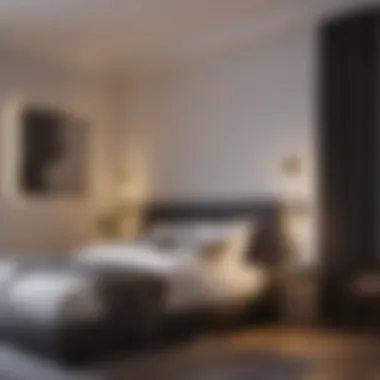
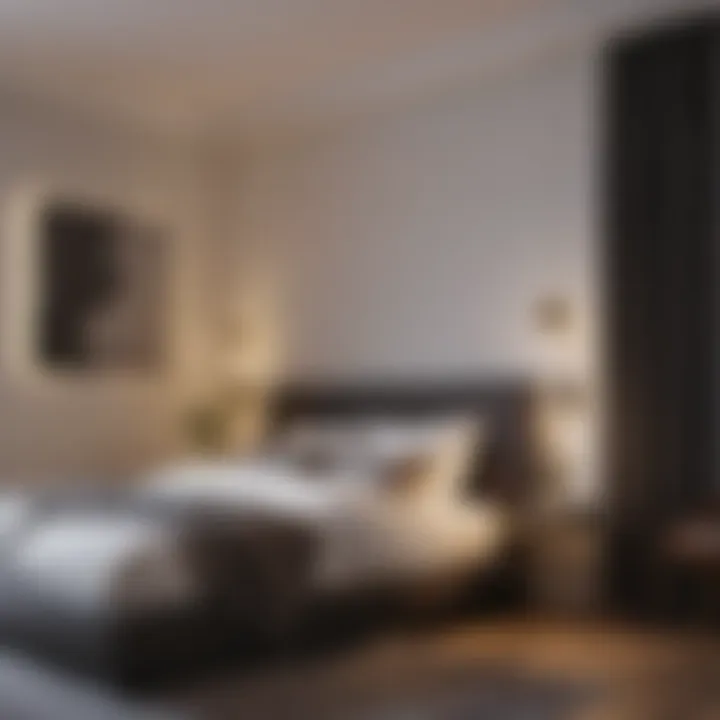
Just as important, accent lighting can influence the mood and energy level of a room. A well-executed lighting scheme can create a relaxing environment that promotes restfulness or a lively and invigorating space for social interactions. This adaptability to changing needs makes accent lighting a valuable tool in any bedroom design.
Creating Focus Points with Accent Lighting
When it comes to creating focus points, the art lies in selecting the right fixtures and positioning them thoughtfully. Here are a few considerations:
- Use of Spotlights: Installing adjustable spotlights can help direct light on features you want to emphasize. This could be a stunning piece of furniture or a well-curated collection of books.
- Wall Sconces: These are perfect for framing areas in your bedroom. Placing sconces around artwork or mirrors can add a dramatic flair that catches the eye.
- Table Lamps: Strategically placed table lamps not only serve a functional purpose but can also be beautiful sculptures in their own right. Consider unique designs that resonate with your personal style.
In essence, accent lighting allows for creativity in your bedroom's design. When crafted carefully, these light sources transform everyday spaces into something remarkable.
Best Practices for Accent Lighting in Bedrooms
To ensure your accent lighting achieves its full potential, consider the following best practices:
- Layer the Light: Incorporate a mix of ambient, task, and accent lighting to create a well-rounded scheme. Each type serves a specific purpose while enhancing the overall design.
- Avoid Overlighting: Too much accent light can detract from its purpose. Focus on subtlety; a soft glow can often create more intrigue than a full-on spotlight.
- Choose the Right Bulb: Opt for bulbs with a warm color temperature to maintain a cozy and inviting atmosphere. This can help accentuate the warmth of your space, making it feel more like home.
- Adjustability: If possible, use adjustable fixtures that allow you to change the direction and intensity of light as needed. This flexibility can be invaluable for catering to different moods or occasions.
- Consistency in Style: Ensure that your accent lighting complements the overall aesthetic of the bedroom. Mismatched fixtures can disrupt the harmony of the space.
Remember, accent lighting should enhance, not overshadow. Use it thoughtfully to create welcoming atmospheres that invite you to unwind.
Natural Light: An Essential Element
Natural light plays a pivotal role in the ambiance of your bedroom. Unlike artificial light, which can often feel harsh or sterile, sunlight offers a gentle warmth that sets a serene tone. This warmth not only enhances the aesthetics of your space but also carries significant psychological benefits. Studies have shown that exposure to natural light can boost mood, improve productivity, and promote better sleep. In fact, integrating natural light in your bedroom can lead to a more restful and rejuvenating experience.
One of the most compelling reasons to embrace natural light is its ability to create a sense of openness and spaciousness. A well-lit room can make even the coziest quarters feel expansive. This is especially important in bedrooms, where a claustrophobic setting can often lead to feelings of stress or discomfort. By maximizing natural light, you can transform your sanctuary into a peaceful retreat.
Maximizing Daylight in Bedroom Design
To tap into the full potential of daylight, begin with the layout of your bedroom. Position your bed near a window, allowing the morning sun to greet you each day. In terms of color choices, keep them light and airy. Soft whites, pastels or light blues can reflect sunlight beautifully, while darker shades might absorb it. Consider using mirrors strategically; they can help bounce natural light around the room, making it feel even larger and brighter.
Also, examine your window coverings. Heavy drapes can block out precious sunlight. Instead, opt for sheer curtains or blinds that let light flow freely while still preserving your privacy. If you live in a location that experiences long periods of overcast skies, consider adding skylights or enlarging existing windows to enhance light intake.
To summarize:
- Position furniture thoughtfully to capitalize on existing windows.
- Choose light colors for walls and décor to reflect light.
- Use sheer window treatments that allow light to filter in.
- Consider skylights for additional daylight.
"Natural light not only enhances space, but it also nurtures the soul. It's about creating an atmosphere that feels alive and inviting."
Complementing Artificial Lighting with Natural Light
While maximizing natural light is key, it's equally vital to recognize the complementing role that artificial lighting plays, especially in the evening hours. The goal is to create a harmonious mix that maintains the warm, inviting feel of daylight while addressing practical nighttime needs. Soft, warm-toned bulbs can mimic the golden hues of sunlight after sunset.
A layered lighting approach works well in this regard. Start with ambient lighting—overhead fixtures or ceiling-mounted lights can provide the necessary base illumination. Next, incorporate task lighting, such as bedside lamps or reading lights, to cater to specific activities. Finally, add accent lighting in the form of wall sconces or LED strips to highlight architectural features or artwork. This layered scheme can complement the natural light that spills in during the day, creating a cohesive atmosphere as the sun sets.
- Utilize warm-toned bulbs for nighttime.
- Implement layered lighting for versatility.
- Blend natural and artificial light for a seamless flow.
By merging both light sources effectively, you can maintain your bedroom as a haven of comfort and style, no matter the hour.
Safety and Practical Considerations
When it comes to bedroom lighting, safety and practical considerations are not just a side note; they are the bedrock of creating a space that is both beautiful and functional. After all, what good is the perfect lamp or light bulb if it poses any risks? Understanding how to choose lighting solutions that meet safety standards can prevent potential hazards and contribute to a more tranquil environment.
Selecting Bulbs that Ensure Safety
The selection of light bulbs is crucial not only for aesthetics but also for safety. One primary aspect is ensuring that the bulbs you choose are compatible with your fixtures. Over time, wearing down of sockets and incorrect bulb types can lead to overheating or even electrical fires.
- Check wattage limits: Always refer to the fixture's maximum wattage specification to avoid exceeding it, which can be a fire hazard.
- Look for safety certifications: Bulbs that have passed safety tests often carry certification stamps, like those from Underwriters Laboratories (UL). This could mean that the bulb is safe to use in your bedroom environment.
- Consider the type of bulb: Some bulbs, like incandescent, generate more heat than their LED counterparts. If you have fixtures in close proximity to fabrics, such as lampshades, opting for cooler bulbs can mitigate fire risks.
Ensuring that bulbs are correctly installed also plays a role in safety. Making sure that they fit snugly and are not damaged is essential. If a bulb flickers or dims unexpectedly, it could be a sign of an electrical issue that should not be ignored.
Understanding Lumens and Wattage
Lumens and wattage can be a bit tricky, but having a grasp on these concepts provides clarity on safety and optimal lighting levels.
- Wattage refers to the amount of energy consumed by the bulb, while lumens measure the brightness provided. It's a common mistake to assume that a higher wattage bulb means more light.
"Choosing the right amount of lumens ensures you don’t end up in a dim-lit cave or under an uncomfortably glaring spotlight."
For example, a 60-watt incandescent bulb typically emits around 800 lumens. With newer LED bulbs, you can achieve the same brightness with just 8 to 12 watts, making them both energy-efficient and cooler in temperature.
When purchasing bulbs, aim to select one that provides sufficient lumens for your space without exceeding the recommended wattage. This results in a well-lit bedroom that is restful and visually appealing while maintaining safety.
Epilogue
In wrapping up our exploration of lighting solutions for your bedroom, we can see how pivotal the right lighting is in shaping your space. The decisions made in selecting fixtures and bulbs are not merely aesthetic; they play a subtle yet significant role in enhancing your comfort, productivity, and mood. From the calming glow of warm light to the sharper clarity of cool tones, each choice directly impacts how you experience your sanctuary.
Recapping Key Points
When it comes to creating an inviting bedroom environment, here are the crucial takeaways:
- Quality of Light: The importance of choosing bulbs with the appropriate color temperature can’t be overstated. Warmer tones create a cozy atmosphere, while cooler shades can help with focus during tasks like reading or studying.
- Energy Efficiency: Emphasizing energy-efficient lighting, especially LED options, not only benefits your wallet in the long run but is also a small yet impactful step towards a more sustainable lifestyle.
- Layered Lighting: Understanding the three types of lighting – ambient, task, and accent – can help you create a dynamic space that suits various activities, from relaxation to work.
- Smart Options: The rise of smart lighting technology allows for unprecedented control and customization. These options can enhance convenience and contribute to energy savings, making them worth considering for modern homes.
- Natural Light Integration: Never underestimate the influence of natural light; designing your space to take full advantage of daylight can enrich your bedroom experience.
Ultimately, achieving the optimal lighting for your bedroom is a carefully woven tapestry of choices, each thread contributing to the beautiful whole. With the points discussed, you're now better equipped to turn your bedroom into a harmonious retreat, suited to both daily routine and restful slumber.



